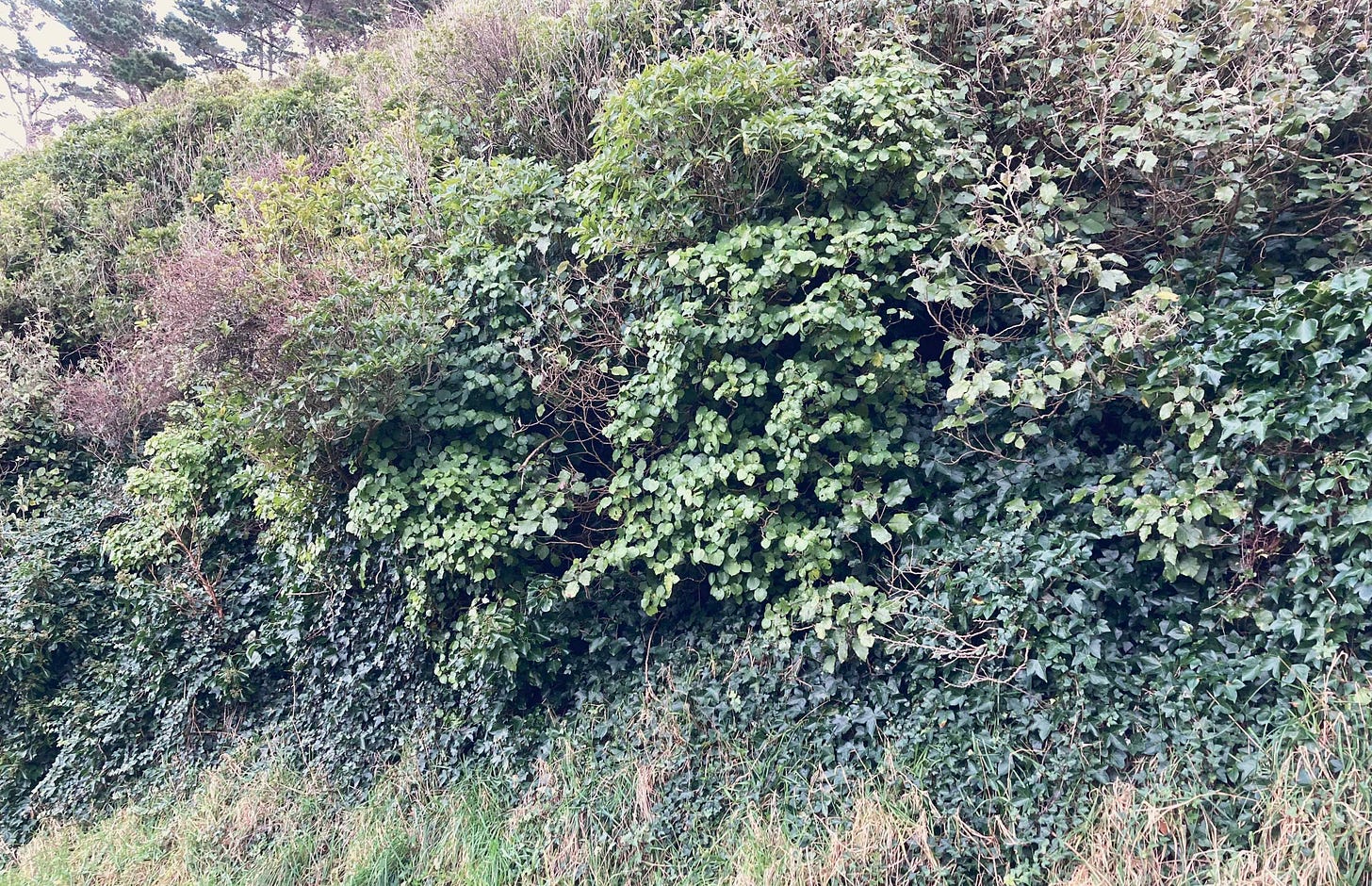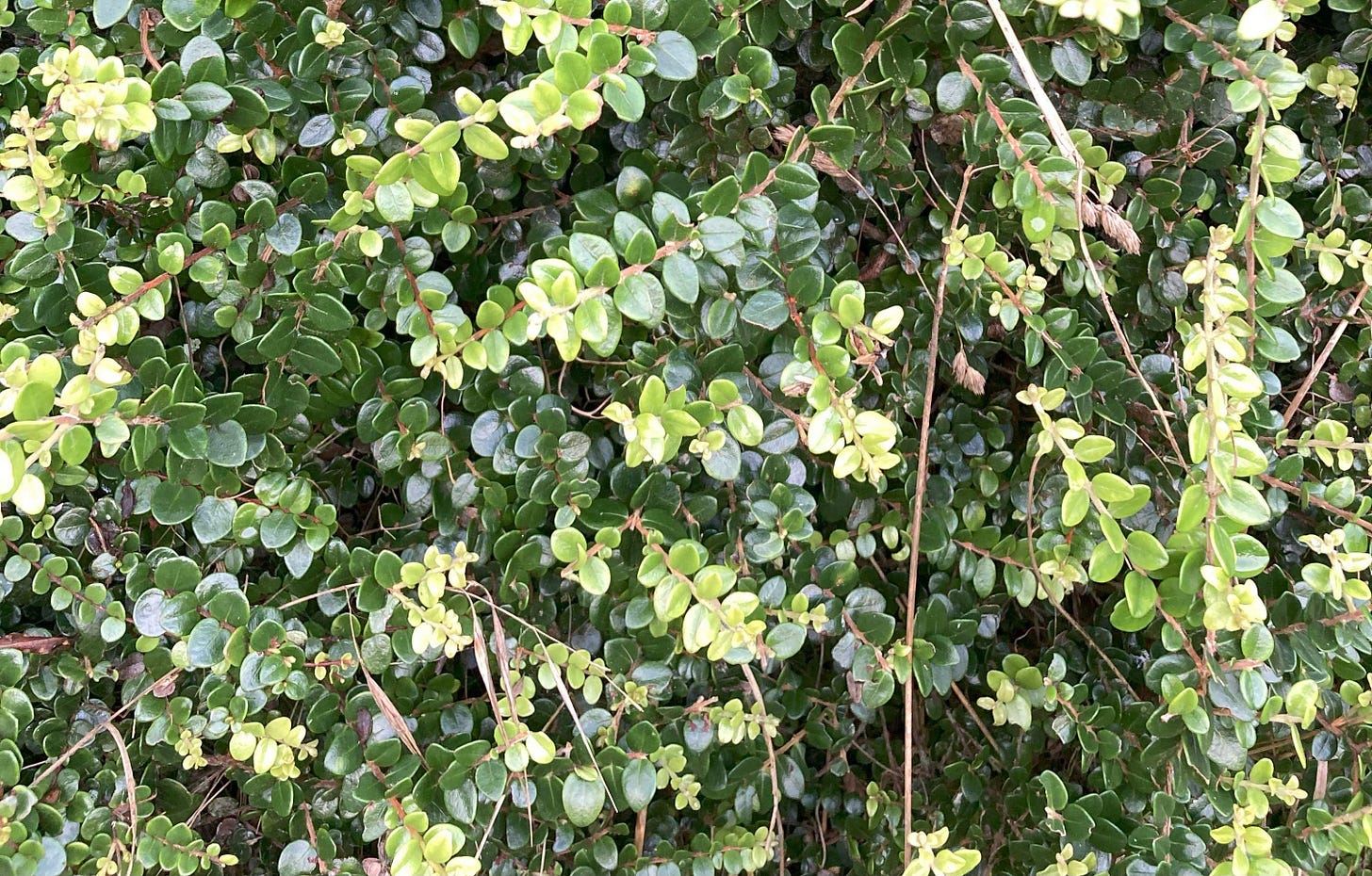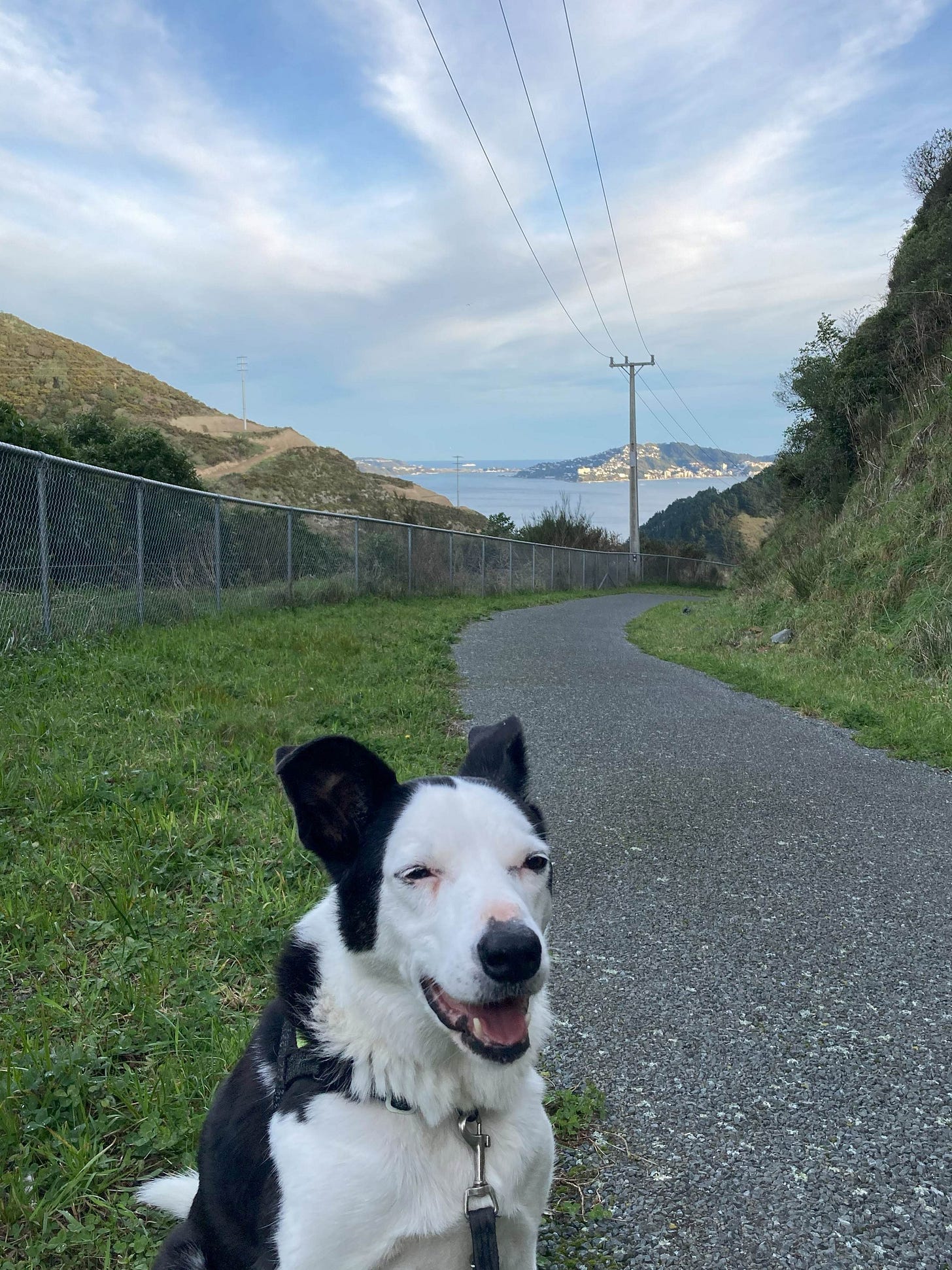Scar tissue
I reflect on the paradoxical place of invasive plants in our landscape (9 minute read, free for all readers)
If I never walk along this track again, I won’t be sorry. I found it on a map and judged, correctly, that it wouldn’t be well-used on a Sunday afternoon and that it would therefore be a good place to take my dog, Donna, for a walk. She seems to agree, darting from one side of the track to the other to be sure she hasn’t missed a smell. I’m looking at the plants, and am less impressed. But it’s a walk, it’s somewhere new, and I’ve made Donna happy.
The track runs from a side street in Newlands, a Wellington suburb perched on hills high above the harbour, down to an industrial area by the motorway at the bottom of the Ngauranga Gorge, beside the motorway. During the week, it gives commuters who want to walk or bike from Newlands into the city a more pleasant and direct route than the path which runs alongside the six lanes of traffic on State Highway One. It’s not really a recreational track.
The start of the track passes a section of the Waitohi Stream, where it appears above the ground for about 100 metres before disappearing into pipes again. It’s much larger than I expect, almost a river, this channel which carries stormwater from three suburbs – Newlands, Johnsonville and Khandallah – to the harbour. I can hear it roaring over the sound of the motorway traffic. Donna is eager. She loves the water, but the Waitohi is behind a chain link fence and at the bottom of a deep channel. She won’t be swimming today.
I know the Waitohi Stream from the branch which flows from the slopes of Tarikākā in Khandallah Park, where the water is clear and pours steadily over the rocks whatever the weather, summer and winter, even in a storm. There, thousands of trees, thick, spongy leaf litter and deep soil accumulated over millennia intercept and filter the rain, moderating Wellington’s downpours and desiccating winds into a dependable flow. But in the suburbs, we can’t wait to get rid of the rain. It rushes off roads and roofs and disappears down drains. When it rains, the streams rise. When it stops, the streams fall. The water is full of road dust and clay. Stormwater infiltrates the sewers in heavy rain, and they overflow. Raw sewage contaminates the stream. That’s the Waitohi I see on the other side of the chain-link fence.
Past the stream, Donna and I walk for another hundred metres beside the motorway, separated from the traffic by a concrete barrier. She’s better behaved than I expect, since heavy traffic can make her anxious. But we soon turn away from the motorway and up the hill. It’s a roughly sealed track, with a chain-link fence on the right-hand side interrupting the view over the industrial area. On the left, the land rises steeply, and is covered by weedy plants. I stop and take a couple of photos of an unusual succulent from the Canary Islands, which has recently been found wild in Wellington. Before this was reported a couple of years ago, I’d never heard of it or seen it, and I’m interested in succulents. Now, I’m seeing it everywhere. There’s even one which has planted itself beside my letterbox.

The start of the track is dominated by common weeds, among them gorse, climbing dock, blackberry, tradescantia, wild radish and various grasses. My eyes skip over them – unless I’m in my local reserve, I barely notice these weeds. Even there, I don’t pay attention unless they are in one of the areas I’m working. But this assemblage of plants is interesting, in a way. The gorse, blackberry and most of the grasses are European. The wild radish probably is too, although it’s also native to parts of Asia and Africa. The climbing dock, however, comes from South Africa, while tradescantia is Brazilian.
It's a cosmopolitan mix, one repeated with slight variations around Wellington. The European or Eurasian species dominate, but there’s always a scattering of plants from other places. In the park across the road from me, there’s Japanese knotweed, native to Asia and causing serious problems in Europe and North America. In nearby Khandallah Park, there’s Darwin’s barberry, from southern Chile. On the steep faces at the base of the Ngaio Gorge, there’s pink ragwort from South Africa and Marguerite daisy from the Canary Islands.
Around New Zealand, we have wild plants from all the temperate areas of the world. We even have some native to high altitude tropical areas such as the Himalayas (wild ginger), the East African highlands (Kikuyu grass) and the high Andes (banana passionfruit). You can take a world tour with our plants.
This doesn’t mean that native plants are banished. As I continue my walk, I see the usual hardy shrubs and small trees of Wellington’s hills, such as māhoe, ngaio, koromiko, karamū and kawakawa. There’s no shortage of the pōhuehue vine, a plant many assume is a weed because it is so rampant. It can smother other plants, but it can also provide shelter for plants which don’t like too much wind or sun. I do spot a couple of native plants I’m always happy to see, even though they are common. There’s a giant tree nettle, one of my favourite plants, best appreciated at a distance. There’s also one of the native rātā vines clinging to a rocky outcrop, its glossy leaves standing out in the gloom of the south-facing slope.
Mostly, I don’t see much to interest me. It’s a mixture of common weeds and common native plants, species I could see anywhere around Wellington. The track remains wide and open, which is good if we meet a dog walking the other way, as it gives me space to walk Donna past while I’m distracting her with a treat. But I never feel the peace I would if I was under a forest canopy. If I turn around, I can see a sliver of harbour, but it’s not an exhilarating view.
We reach the end of the track and emerge onto a suburban street. There’s a park across the road, where I find a rubbish bin to deposit the plastic bags I’ve been carrying. Then we turn to walk back down the track. I try to reflect on what I’m seeing, to uncover a deeper picture of this place. Gradually, an image emerges.
A deep, south-facing gully like this would once have held dense forest, the tree branches heavy with epiphytes and the ground thick with ferns and mosses. I’m not sure of the Māori history in this precise spot, but most of the forest probably still remained when Europeans arrived. In the late 19th century, the forest would have been logged then burned, and grass sown. Settlers would have tried and failed to turn the slopes into economic farms, battling erosion and low fertility as the soil once protected by the forest was washed into the harbour by heavy rain. Perhaps they read the advice to plant gorse as a fodder plant which tolerated infertile soils. In any case, within a few decades, they had given up their efforts, and the prickly, flammable gorse had claimed the slopes.
As long as the land burned every decade or so, the gorse would have persisted. But we don’t like fires near our homes, so we did our best to prevent them. Slowly, almost imperceptibly at first, plants which had been banished to a few refuges made their return. In the bellies of blackbirds, berries of karamū, māhoe, ngaio and pōhuehue arrived. In the shelter of the gorse, they grew. Eventually, they grew taller than the gorse, shading it out, confining it to edges and gaps. Soon, other native plants returned, kawakawa, rangiora, the rātā vine, the tree nettle.
Blackbirds brought more than native plants, though – they also brought blackberry, Japanese hill cherry, ivy and Darwin’s barberry. There’s a stand of planted pine trees. Tradescantia creeps from nearby gardens. Everything grows, despite the wind and shallow soil.
If we were all to walk away from Wellington tomorrow, this is what would remain. This gully will never regrow the rich, diverse rainforest which once surrounded the harbour, not even if we leave it for thousands of years. Without any predator control, stoats and rats would destroy the native birdlife, and even some of the introduced birds. Kohekohe, the tropical-looking tree which was once a major part of the forest canopy here, wouldn’t stand a chance against the possums. But there are some native plants which are less delicious to possums, and they will survive.
Even with our best efforts, we won’t eliminate the most invasive of the introduced plants here. There’s too much steep, unstable and inaccessible land, and too many plants which grow too fast and spread too easily. We can protect some areas, but mostly we have no choice but to let this new nature we have created take its course.
The forest here will always be a hybrid of the hardier natives and plants which would never have reached this land had we not brought them. Does this really matter? To some extent, it must, because New Zealand’s plants are mostly found nowhere else, while the introduced species which have gone wild here are, by and large, the same species which have gone wild when introduced to similar climates in Australia, South America and South Africa, as well as temperate areas of the northern hemisphere. We are homogenising the Earth’s landscape with the same set of plants and animals everywhere, while many unique, local species are shoved to the side.

Yet the forest which is now regenerating on the steep slopes of this gully is still forest. That’s important, because it’s what the land here needs. Even if it’s a mix of māhoe and Japanese hill cherry, pōhuehue and blackberry, native ferns and tradescantia, it’s better than grass. The mass of roots will stabilise the shattered earth. The leaves will intercept the rain and build up a layer of litter. Microbes will turn the leaf litter into soil. The trees will absorb more carbon dioxide from the atmosphere than they emit. Inside the forest, the temperature will be moderated and the air humidified. The water will be filtered and cleaned and the Waitohi’s fluctuating flow will be mellowed.
The forest here is a scab on the land, growing over the wound we created with ignorance and arrogance. It’s leaving a scar which looks, to my eyes, raw and distorted, nothing like what we destroyed. But it’s healing, and sometimes that’s good enough.







👍 Fascinating analysis - love both of your conclusions = "the dog got a walk" 😁 & the new forest not being the same as the one destroyed but "sometimes that's good enough" in view of the fact the old one can't/won't come back 🥹
On a re-planting project I volunteered on, we used the gorse as a "nursery" for the natives we planted, some of which I was lucky to see grow above & kill the gorse. It was bush turned into farm turned into abandoned, and the pasture grass was the biggest "weed" and hardest to fight in open areas - constant weeding else it choked & smothered 🤷
Indeed, "sometimes that's good enough"....